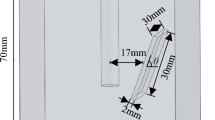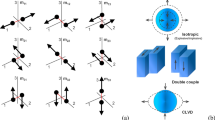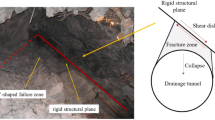Abstract
To investigate the characteristics of the sandstones under two fracture modes which are tensile fracture and shear fracture, we proposed three-point bending test and a modified shear test. Meanwhile, numerical simulations using particle flow code (PFC) and acoustic emission (AE) analysis are performed to obtain their differences. The AE hits and amplitude analyses prove that no matter which mode, they experience obvious three stages. The AE hit curve and amplitude are lower in the first stage. Then, the curve goes up steadily and the amplitude value becomes relatively large in the second stage. Entering into the third stage, the curve increases quickly to its peak value and a lot of AE signals with higher amplitude are generated. Moreover, AE b-value analysis is also used to make crack magnitude assessment. It was obvious that the distribution of b-value curve can be divided into three stages, which are just corresponding to the division of AE hits and amplitude distributions. The b-values are diverse and fluctuating largely in stage I and then show small fluctuations and have increasing trends in the whole process in stage II whereas finally exhibit sharp down to the minimum points at the stage III. The average b-values for tensile fracture tests are in the range of 0.877–1.09 whereas for shear fracture tests are within the range of 0.815–0.876. Comparing to tensile fracture, when shear fracture occurs in the rock sample, the AE energy releases faster and the proportion of large magnitude cracks is larger. The research results in this article could make more instructive and applied value to in situ non-destructive monitoring of fissure development for engineering rock mass.
















Similar content being viewed by others
References
Aggelis DG (2011) Classification of cracking mode in concrete by acoustic emission parameters. Mech Res Commun 38(3):153–157
Aggelis DG, Mpalaskas AC, Matikas TE (2013) Investigation of different fracture modes in cement-based materials by acoustic emission. Cem Concr Res 48:1–8
An L, Jin C, Liu D, Ding C, Dai X (2017) Mechanism of core discing in the relaxation zone around an underground opening under high in situ stresses. Bull Eng Geol Environ 77:1179–1189. https://doi.org/10.1007/s10064-017-1168-3
Barton N, Shen B (2017) Risk of shear failure and extensional failure around over-stressed excavations in brittle rock. J Rock Mech Geotech Eng 9(2):210–225
Cai M, Kaiser PK, Morioka H, Minami M, Maejima T, Tasaka Y, Kurose H (2007) FLAC/PFC coupled numerical simulation of AE in large-scale underground excavations. Int J Rock Mech Min Sci 44(4):550–564
Carpinteri A, Corrado M, Lacidogna G (2012) Three different approaches for damage domain characterization in disordered materials: fractal energy density, b-value statistics, renormalization group theory. Mech Mater 53:15–28
Cooper GA (1977) Optimization of the three-point bend test for fracture energy measurement. J Mater Sci 12(2):277–289
Cui ZD, Liu DA, Zeng RS, Niu JR, Wang HJ, Shi XS (2013) Resistance of caprock to hydraulic fracturing due to CO2 injection into sand lens reservoirs. Eng Geol 164:146–154
Dai SH, Ma SL, Pan YS et al (2012) Evaluation of mode I stress intensity factors of rock utilizing digital speckle correlation method. Chin J Rock Mech Eng 31(12):2501–2507
Dimitrios G. Aggelis, (2011) Classification of cracking mode in concrete by acoustic emission parameters. Mechanics Research Communications 38 (3):153–157
Eberhardt E, Stead D, Stimpson B et al (1997) Changes in acoustic event properties with progressive fracture damage. Int J Rock Mech Min Sci 34(3):71.e1–71.e12
EN 13892-2:2002 (2002) Methods of test for screed materials-part 2: determination of flexural and compressive strength
Fowell RJ (1995) Suggested method for determining mode I fracture toughness using cracked chevron notched Brazilian disc (CCNBD) specimens. Int J Rock Mech Min Sci Geomech Abstr 32(1):57–64
Girard L, Gruber S, Weber S, Beutel J (2013) Environmental controls of frost cracking revealed through in situ acoustic emission measurements in steep bedrock. Geophys Res Lett 40(9):1748–1753
Guo T, Zhang S, Qu Z, Zhou T, Xiao Y, Gao J (2014) Experimental study of hydraulic fracturing for shale by stimulated reservoir volume. Fuel 128:373–380
He MC, Zhao F, Cai M, du S (2015) A novel experimental technique to simulate pillar burst in laboratory. Rock Mech Rock Eng 48(5):1833–1848
Hirata A, Kameoka Y, Hirano T (2007) Safety management based on detection of possible rock bursts by AE monitoring during tunnel excavation. Rock Mech Rock Eng 40(6):563–576
Hoover SE, Greenawalt W, Tittmann B (2015) Experimental and theoretical modeling of expansion in pyritic shale. Geotech Test J 38(2):166–178
Itasca Consulting Group Inc (2002) PFC2D (particle flow code in 2 dimensions) theory and background R. Itasca Consulting Group Inc, Minnesota
Khan K, Al-Shayea NA (2000) Effect of specimen geometry and testing method on mixed mode I–II fracture toughness of a limestone rock from Saudi Arabia. Rock Mech Rock Eng 33(3):179–206
Khosravi A, Sadaghiani MH, Khosravi M et al (2013) The effect of asperity inclination and orientation on the shear behavior of rock joints. Geotech Test J 36(3):404–417
Kurz JH, Finck F, Grosse CU (2006) Stress drop and stress redistribution in concrete quantified over time by the b-value analysis. Struct Health Monit 5(1):69–81
Li N, Wang E, Ge M, Liu J (2015) The fracture mechanism and acoustic emission analysis of hard roof: a physical modeling study. Arab J Geosci 8(4):1895–1902
Liu D, Wang S, Li L (2000) Investigation of fracture behaviour during rock mass failure. Int J Rock Mech Min Sci 37(3):489–497
Moradian ZA, Ballivy G, Rivard P, Gravel C, Rousseau B (2010) Evaluating damage during shear tests of rock joints using acoustic emissions. Int J Rock Mech Min Sci 47(4):590–598
Potyondy DO (2012) A flat-jointed bonded-particle material for hard rock. 46th US rock mechanics/geomechanics symposium. American Rock Mech Association, Alexandria
Puller JW, Mills KW, Jeffrey RG et al (2016) In-situ stress measurements and stress change monitoring to monitor overburden caving behaviour and hydraulic fracture pre-conditioning. Int J Rock Mech Min Sci 26(1):103–110
Richter CF (1958) Elementary seismology. WH Freeman and Company, San Francisco, pp 136–139
Sagar RV, Prasad BK, Kumar SS (2012) An experimental study on cracking evolution in concrete and cement mortar by the b-value analysis of acoustic emission technique. Cem Concr Res 42(8):1094–1104
Stanchits S, Surdi A, Gathogo P, Edelman E, Suarez-Rivera R (2014) Onset of hydraulic fracture initiation monitored by acoustic emission and volumetric deformation measurements. Rock Mech Rock Eng 47(5):1521–1532
Ulusay R (2015) The present and future of rock testing: highlighting the ISRM suggested methods, The ISRM suggested methods for rock characterization, testing and monitoring: 2007–2014. Springer, Cham, pp 1–22
Wang QZ, Jia XM, Kou SQ, Zhang ZX, Lindqvist PA (2003) More accurate stress intensity factor derived by finite element analysis for the ISRM suggested rock fracture toughness specimen-CCNBD. Int J Rock Mech Min Sci 40(2):233–241
Wang HJ, Zhao F, Huang ZQ, Yao Y, Yuan G (2017) Experimental study of mode-I fracture toughness for layered shale based on two ISRM-suggested methods. Rock Mech Rock Eng 50(7):1933–1939
Wuestefeld A, Verdon JP, Kendall JM et al (2011) Inferring rock fracture evolution during reservoir stimulation from seismic anisotropy. Geophysics 76(6):157–166
Xeidakis GS, Samaras IS, Zacharopoulos DA, Papakaliatakis GE (1996) Crack growth in a mixed-mode loading on marble beams under three point bending. Int J Fract 79(2):197–208
Xeidakis GS, Samaras IS, Zacharopoulos DA, Papakaliatakis GE (1997) Trajectories of unstably growing cracks in mixed mode I–II loading of marble beams. Rock Mech Rock Eng 30(1):19–33
Xu JN et al (1994) Multi-crack rock mass mechanical character under the state of compression shearing fracture and damage evolution and testing verification. Chin J Rock Soil Mech 15(2):1–12
Xu F, Yang C, Guo Y et al (2017) Effect of bedding planes on wave velocity and AE characteristics of the Longmaxi shale in China [J]. Arab J Geosci 10(6):141
Zhao F, He MC (2017) Size effects on granite behavior under unloading rockburst test. Bull Eng Geol Environ 76(3):1183–1197
Funding
This work was financially supported by the Key projects of the Henan joint fund of National Natural Science Foundation of China (CN) (No: U1704243), the Plan For Scientific Innovation Talent of Henan Province (No: 154100510006), the National Natural Science Foundation of China (Nos.: 41807254, 51704120, 51309100, 41602330), the Science and Technology Research Project of Henan Province (182102310714), the Key scientific research projects of Henan province colleges (No: 18A170008), and the North China University of Water Resources and Electric Power High-level Scientific Research Funds (Nos.: 40468, 40583).
Author information
Authors and Affiliations
Corresponding author
Rights and permissions
About this article
Cite this article
Wang, H., Zhao, F., Huang, Z. et al. Study on acoustic emission characteristics of sandstone under different fracture modes. Arab J Geosci 11, 772 (2018). https://doi.org/10.1007/s12517-018-4115-0
Received:
Accepted:
Published:
DOI: https://doi.org/10.1007/s12517-018-4115-0




